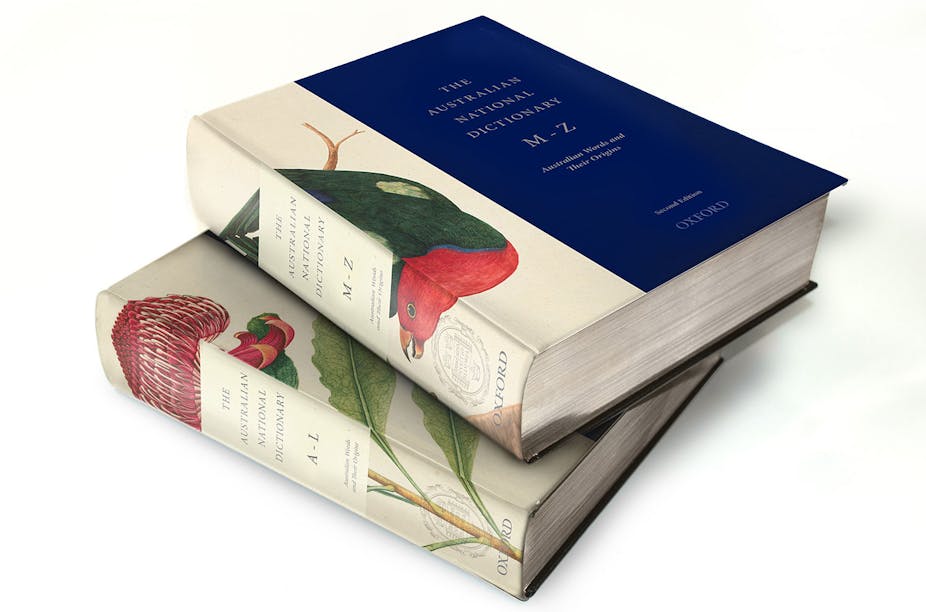There’s a new arrival on the dictionary scene – the much-anticipated second edition of the Australian National Dictionary, known fondly as AND.
As I recently wrote, these beautiful two volumes should certainly put to rest any fears people might have about the continued place of “tree-dictionaries” in an age of e-books and digital libraries.
These more than 16,000 Australianisms have generated lots of excitement – and not surprisingly. Words are the most observable part of any language and English-speakers seem fascinated by the ins and outs of expressions.
Look at the media attention when dictionaries announce the winner of their Word of the Year competition. There’s nowhere near the same excitement with other aspects of the language.
There were no breaking news stories when linguists announced developments affecting the conjunction “because” (for example, “I’ve been missing out on sleep because binge-watching Game of Thrones” or “I missed the ending because fell asleep”).
Dictionary editors are among the new celebrities, answering questions like: what is the longest word in the language? Is there a word to describe those who drink their own bathwater? How many words do speakers know? And, perhaps the thorniest question of all – when should new expressions enter the dictionary?
Vocabulary changes more than other aspects of language and lexicographers are constantly redrawing the exclusion boundary for marginal vocabulary items. “Yeah-no” has been around since the 1990s, but is only now appearing in dictionaries.
And while many original misspellings now have entries, such as “miniscule” (with its erroneous “i”) and even “nucular”, an entry for “accomodation” (with one “m”) seems a long way off.
It’s not easy for dictionary-makers. They are seen as the guardians of the language and when they take on board expressions like “yeah-no” and “nucular”, we hear howls about declining standards. Yet people will usually discard dictionaries if they don’t keep up-to-date.
Dictionary-making was more straightforward for early lexicographers, who sourced words almost exclusively from books. So, it was formal written language that typically made it into dictionaries.
Words were written on cards each time they were used and, when there was a substantial collection of cards, it could be established that a word was in general usage. So, they were largely respectable expressions, and anything that snuck under the radar would be well and truly branded (originally with symbols like asterisks or daggers, and later with more precise usage labels like “low”, “barbarous”, “vulgar”, as appeared in Samuel Johnson’s 1755 dictionary).
These days it’s all very different. Lexicographers consider an array of different language forms, including newspapers, magazines, pamphlets, menus, memos, TV and radio broadcasts and, of course, emails, chat-room discussions and blogs.
So it’s not surprising to find that the informal aspect has been significantly boosted in the new-look AND. Of course, this reflects the strong attachment to the vernacular in Australia, but it’s also in keeping with the marked shift towards informal ways of speaking and writing generally – even public language is becoming progressively more casual and everyday.
So dictionaries are now much faster to take up “slanguage”. In the Collins Official Scrabble Words, even “innit” (“isn’t it”), “grrl” (“feisty female”) and “thang” (“thing”) have the stamp of approval. Once it could take years and years for such colloquialisms to appear in print, perhaps then to be picked up by lexicographers and placed in some dictionary — or perhaps never.
So like many other dictionaries these days, AND shows an assortment of distinguished entries and boisterous slang. Additions from the world of economics and politics, for example, include sedate terms-of-art (“aspirational voter”, “economic rationalism”, “negative gearing”, “scrutineer”) as well as colloquialisms (“keep the bastards honest”, “Hawkespeak”, “hip-pocket nerve”, “wombat trail”).
And the current editorial team has continued the AND tradition and not tagged these entries with labels like “colloquial” or “slang” (though “-ist” language is occasionally labelled derogatory).
So don’t believe the concerned hype that accompanied the 2014 edition of Tony Thorne’s Dictionary of Contemporary Slang. It added only three new Australianisms (“tockley” for “penis”, “ort” for “buttocks” and “unit” for “bogan”), prompting a frenzy of headlines like:
The rise and fall of Australian slang.
I’m not sure how Thorne missed “selfie”, Australia’s contribution to the international lexicon – after all, it was the Oxford Dictionaries’ Word of the Year in 2013.
Articles expressed the fear that the glory days of Australian slang were over. AND should help to quell such fears – “hornbag”, “budgie smugglers”, “grey nomad”, “chateau cardboard” are among the many treasures you will find there.
Some of these entries appear so scruffy that you might wonder at the wisdom of the editors including them at all (“snot block”, “ranga”, “reg grundies”, “ambo”, “rurosexual”, “seppo”, “trackie daks”, “spunk rat”, “goon of fortune” come to mind). Of course, slang is in the eye of the beholder – even Samuel Johnson included a few (unbranded) personal favourites, like “belly timber” for “food”.
But in this case, you can take comfort in the fact that these expressions will have been tracked and meticulously analysed. They aren’t newly minted coinages and wouldn’t be there unless they “had legs”.
It seems to me almost impossible for printed dictionaries to keep up with the changing nature of vocabulary these days. People just love creating words.
In fact, scientists have recently discovered that learning the meaning of new words can stimulate exactly those same pleasure circuits in our brain as sex, gambling, drugs and eating, the pleasure-associated region called the ventral striatum.
The surge of excitement when we encounter a new word is the recently coined “neologasm”. And that really says it all.

